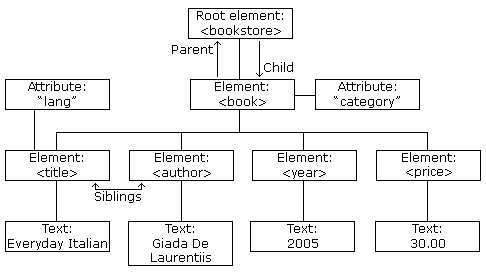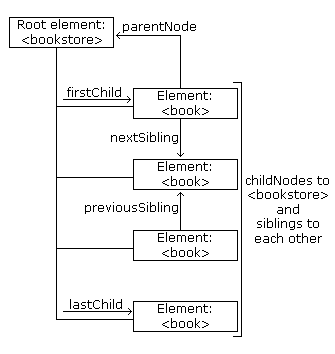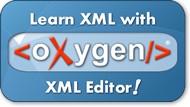XML DOM Node Tree


The XML DOM views an XML document as a node-tree.
All the nodes in the tree have a relationship to each other.
The XML DOM Node Tree
The XML DOM views an XML document as a tree-structure. The tree structure is
called a node-tree.
All nodes
can be accessed through the tree. Their contents can be
modified or deleted, and new elements can be created.
The node tree shows the set of nodes, and the connections
between them. The tree starts at
the root node and branches out to the
text nodes at the lowest level of the tree:

The image above represents the XML file books.xml.
Node Parents, Children, and Siblings
The nodes in the node tree have a hierarchical relationship to each other.
The terms parent, child, and sibling are used to describe
the relationships. Parent nodes have
children. Children on the same level are called siblings
(brothers or sisters).
- In a node tree, the top node is called the root
- Every node, except
the root, has exactly one
parent node
- A node can have any
number of children
- A leaf is a node with no children
- Siblings are nodes with the same parent
The following image illustrates a part of the node tree and the
relationship between the nodes:

Because the XML data is structured in a tree form, it can be traversed without
knowing the exact structure of the tree
and without knowing the type of data contained within.
You will learn more about traversing the node tree in a later chapter of this
tutorial.
First Child - Last Child
Look at the following XML fragment:
<bookstore>
<book category="cooking">
<title lang="en">Everyday Italian</title>
<author>Giada De Laurentiis</author>
<year>2005</year>
<price>30.00</price>
</book>
</bookstore>
|
In the XML above, the <title> element is the first child of the <book>
element, and the <price> element is the last child of the <book> element.
Furthermore, the <book> element is the parent node of the <title>,
<author>, <year>, and <price> elements.


Learn XML with <oXygen/> XML Editor - Free Trial!
 |
|
oXygen helps you learn to define,
edit, validate and transform XML documents. Supported technologies include XML Schema,
DTD, Relax NG, XSLT, XPath, XQuery, CSS.
Understand in no time how XSLT and XQuery work by using the intuitive oXygen debugger!
Do you have any XML related questions? Get free answers from the oXygen
XML forum
and from the video
demonstrations.
Download a FREE 30-day trial today!
|
|